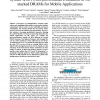Free Online Productivity Tools
i2Speak
i2Symbol
i2OCR
iTex2Img
iWeb2Print
iWeb2Shot
i2Type
iPdf2Split
iPdf2Merge
i2Bopomofo
i2Arabic
i2Style
i2Image
i2PDF
iLatex2Rtf
Sci2ools
DATE
2009
IEEE
2009
IEEE
System-level power/performance evaluation of 3D stacked DRAMs for mobile applications
Abstract—Convergence of communication, consumer applications and computing within mobile systems pushes memory requirements both in terms of size, bandwidth and power consumption. The existing solution for the memory bottleneck is to increase the amount of on-chip memory. However, this solution is becoming prohibitively expensive, allowing 3D stacked DRAM to become an interesting alternative for mobile applications. In this paper, we examine the power/performance benefits for three different 3D stacked DRAM scenarios. Our high-level memory and Through Silicon Via (TSV) models have been calibrated on state-of-theart industrial processes. We model the integration of a logic die with TSVs on top of both an existing DRAM and a DRAM with redesigned transceivers for 3D. Finally, we take advantage of the interconnect density enabled by 3D technology to analyze an ultra-wide memory interface. Experimental results confirm that TSV-based 3D integration is a promising technology option for futu...
| Added | 20 May 2010 |
| Updated | 20 May 2010 |
| Type | Conference |
| Year | 2009 |
| Where | DATE |
| Authors | Marco Facchini, Trevor Carlson, Anselme Vignon, Martin Palkovic, Francky Catthoor, Wim Dehaene, Luca Benini, Paul Marchal |
Comments (0)

